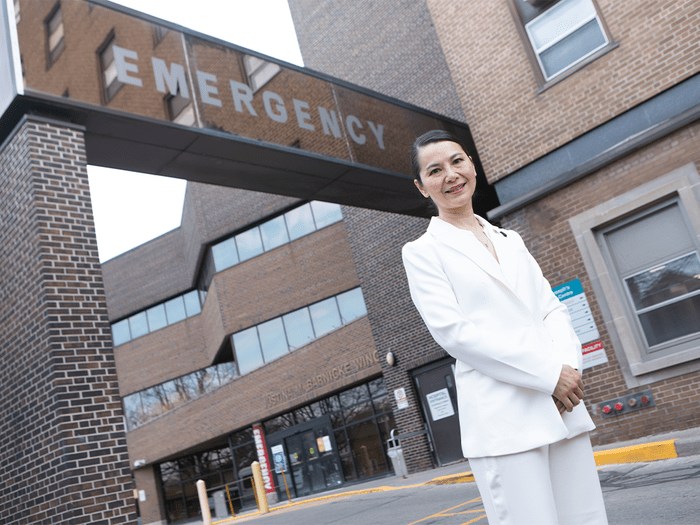Lessons From The Pandemic: How I Learned to Prepare For The Unknown

Dr. Joan Cheng, the GTA’s first Asian, female ER Chief, on how she and her staff managed throughout the pandemic, the country’s first post-COVID emergency department and how the pandemic is going to change care.
I remember being so scared during the SARS epidemic in 2003. I was working in an emergency department in the Greater Toronto Area (GTA), and nothing had prepared me for a novel disease that would change everything—from patient interactions to how safe I felt at work.
Back then, the only time a health care provider wore a mask was in the operating room. So, the first time I wore a mask to see a patient, it honestly felt as weird as if I had gone to see a patient in my underwear. A senior male colleague actually mocked me for “looking ridiculous,” but I’m glad I kept wearing my mask because it protected me from the virus and saved my life.
In March 2020, I recognized that same fear I once felt in my junior colleagues. I understood the mental leapfrogging they were doing—thinking about how their job might put their life, and the lives of their loved ones, in danger. We started to hear more news of the novel coronavirus and began admitting COVID patients to Markham Stouffville Hospital in the Greater Toronto Area, where I was working. That’s when it became clear that COVID-19 was going to hit Canada. My partner, who is also an emergency physician, and I got our wills in order and came up with protocols about what would happen if we got sick at work. I knew that all we could do was to be as prepared as possible with the limited knowledge we had of this new virus.
(Related: Experts Advise Being ‘Super Safe’ As Canada Enters the 4th Wave of COVID)
Preparing for the unprecedented
Our hospital was hit hard early in the pandemic. Our hospital had some of the highest numbers of admitted COVID patients in the GTA. Patients stopped coming to the emergency department due to fear, so our waiting rooms were eerily empty except for the sickest patients who couldn’t avoid coming. We were rapidly changing how we worked to respond to an ever-evolving situation, all in absence of guidelines.
We realized that we needed to learn and implement new best practices quicky, so we created simulation scenarios and practiced, for example, how to resuscitate a patient when they have COVID. Usually, when a patient is being resuscitated—meaning treating a patient who’s stopped breathing or doesn’t have a heartbeat—medical staff are going in and out of the room constantly. But that wasn’t safe during COVID. We couldn’t just open the door because it would allow germs to come out. So how do we pass equipment and talk to the team inside the room?
Starting March 6, 2020 we ran over 20 simulations in nine weeks. We created new protocols using a two-door system so staff could enter a patient’s room without allowing germs to escape. We used the three-way calling function on dedicated cellphones so we could consult all the team members even if they weren’t in the same room. We had whiteboards on hand in case there was a phone failure, so at least you could show what you needed through the glass. These solutions were crowdsourced in several ways: consultations with colleagues, ideas shared on social media and trial and error.
(Related: What You Need to Know About COVID Variants in Canada)
Responding to the rise in anti-Asian racism
There was an incident at our hospital where a patient expressed extremely hateful anti-Asian sentiments to everyone near him, including an Asian health care worker, who remained calm and professional. There weren’t any specific protocol in place for dealing with this; however, as a result, we created a system to start tracking these incidents and started working on a more robust protocol to respond to future incidents.
In my new position at Toronto’s St. Joseph’s Health Centre, I’m the first woman of East Asian descent to be a lead an Emergency Department (ED) in the GTA. I feel a lot of pressure not to fail, so that can be overwhelming. To cope with this, I try to take the focus off myself, and I remember how it’s not about me; it’s about all the women that are coming right behind me. I think representation is so important and I was reading about Kim Ng, who’s major league baseball’s first East Asian General Manager, as well as MLB’s first woman GM, and she always says, “you can’t be it if you can’t see it.”
(Related: How to Be an Ally to the Asian Canadian Community)
Constructing new health care spaces
When I accepted the role of ED Chief, I took all of my experiences with me. The hospital has plans to renovate the emergency department starting this month and I was happy to arrive before demolition began. It meant that my team and I could use what we’ve learned from the pandemic to inform the changes we wanted to make and reshape emergency care.
A lot of the changes we’re planning have to do with infection prevention and control. For example, your typical emergency department has a bay with lots of stretchers that are separated by curtains. Ideally, stretchers will be separated by walls that can be wiped down and that keep viruses contained. Walls also have the added benefit of reducing background noise. Noise adds up, especially in the ED where we have alarms, equipment and people talking, and that can create a chaotic environment for both patients and health care workers. Our hope is that having separate patient rooms will create a calmer environment.
During COVID-19, we also learned how proper ventilation can help decrease virus transmission indoors. In our new emergency department, we’re making sure the HVAC system standards are met, including making sure that we have sufficient airborne infection isolation rooms (AIIR) to safely care for our patients. AIIR rooms are under “negative pressure,” meaning the air pressure inside the room is lower than outside the room. When the door opens, potentially contaminated air inside the room won’t flow outside, and is instead vented through an exhaust system that cleans the air before it is pumped outside the building.
We’re also boosting our internal communications by building in an intercom system so we don’t need to MacGyver a solution with iPhones or baby monitors, which are used in many emergency departments.
(Related: Going the Distance: How Covid Has Remapped Friendships)
How the pandemic is changing patient care
Going forward, it’s entirely possible health care staff will wear a mask for every patient encounter. SARS did change masking protocols, and many health care workers don a mask when it’s more likely a patient is infectious, but now health care workers may do this for all patients, rather than for select patients.
The need for need for good translation services came to the forefront during the pandemic. Over 140 languages and dialects are spoken within the city of Toronto alone and normally, we were almost always able to have a family member or friend present to translate. With COVID, we didn’t permit any visitors to accompany patients, so we had to have a family member translate over the phone, which is not easy.
The pandemic made me more aware of the importance of connecting with patients and how I took that for granted. Like, the ability to shake a patient’s hand, or to discuss an issue with the patient and their loved ones.
During the pandemic, we had to call loved ones to get information and keep them informed, instead of being able to speak with them in-person. That meant learning a new form of patient communication on the fly. We had to be very intentional. What do I need to tell this person in a very simple and precise way? How can I do this in a sensitive way since they can’t see my facial expressions? I found myself apologizing a lot more. Apologizing for having to talk to them about a very serious problem over the phone instead of face-to-face. Apologizing for having a frightening discussion without any warning over the phone. Specifically, apologizing for telling them their loved one was struggling to breathe and that we would have to intubate them in the next few minutes and asking if we have permission to do so.
(Related: First Person: “I Am Astounded That I Survived”)
The toll on health care workers
It’s been really, really tough for so many health care professionals. Our staff are so dedicated and it’s hard for them to leave work because they’re so worried about their colleagues and the workload they need to shoulder. But you can only overwork yourself so long before your reserves run out, so I’m worried that we’ll see significant healthcare provider shortages as people retire early or switch careers. Right now, as there’s capacity in the hospitals, we need to allow health care providers to just take a break and reenergize and hope that they’ll come back to work. I was lucky enough to take two weeks off this summer—my first break since March of 2020.
How the pandemic has changed me
The pandemic made me reflect on my priorities in life and how to make sure I spent time on people and on things that were meaningful to me. As a physician, I was able to witness the skill, compassion and dedication of my colleagues. It was hard, and still is hard, to see how the brunt of this pandemic has fallen on the shoulders of my nursing colleagues, and I struggle to find meaningful ways to support the incredible people who do this very difficult job.
I’ve learned that in times of new uncertainty, it’s important to always be honest about what you do and don’t know. No one is expecting anyone to have all the answers, and in situations where you don’t have the answers, adopt the “precautionary principle”— meaning that complete evidence of risk isn’t necessary to take action to mitigate risk —until you get more information. Once the evidence is available, let it guide your decision making. Always prioritize and value your people, they’re the backbone of any organization. Frontline workers are the experts—listen to them. And don’t be married to “being right”—if your initial decision was wrong, that’s OK, but be humble enough to admit it and nimble enough to change your course as needed.
Can we ever be completely prepared for the unknown? No, but these guiding principles, and lessons from the pandemic, are helping me and my team better prepare for whatever comes next.
Next, here are four ways the pandemic has taken a toll on our bodies.




